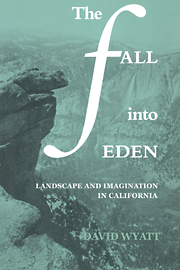Book contents
- Frontmatter
- Contents
- List of illustrations
- Acknowledgments
- Prologue: The mythology of the region
- 1 Spectatorship and abandonment: Dana, Leonard, and Frémont
- 2 Muir and the possession of landscape
- 3 King and catastrophe
- 4 Mary Austin: nature and nurturance
- 5 Norris and the vertical
- 6 Steinbeck's lost gardens
- 7 Chandler, marriage, and “the Great Wrong Place”
- 8 Jeffers, Snyder, and the ended world
- Epilogue: Fictions of space
- Notes
- Bibliography
- Index
Prologue: The mythology of the region
Published online by Cambridge University Press: 18 December 2009
- Frontmatter
- Contents
- List of illustrations
- Acknowledgments
- Prologue: The mythology of the region
- 1 Spectatorship and abandonment: Dana, Leonard, and Frémont
- 2 Muir and the possession of landscape
- 3 King and catastrophe
- 4 Mary Austin: nature and nurturance
- 5 Norris and the vertical
- 6 Steinbeck's lost gardens
- 7 Chandler, marriage, and “the Great Wrong Place”
- 8 Jeffers, Snyder, and the ended world
- Epilogue: Fictions of space
- Notes
- Bibliography
- Index
Summary
As you drive south from Pasadena to Long Beach, the freeway follows the bed of the Los Angeles River. The river is paved. A trickle runs down the central cement aisle except during flash floods. Just after the freeway crosses the river there is an off-ramp for “Imperial Highway.” Multicolored homes fan out in all directions below. There was a house here once, white stucco with palms out front and a good piece of land out back, shaded by persimmon trees. It was called “The Acre.” Dairy farms surrounded it, and anything would grow there. You planted or bred whatever you could sell during the Depression: rhubarb, corn, dogs, worms. Fogs off the ocean checked the summer sun, and in the winter the heavy rains came. My father survived the quake of '33 there, and, after the war, the brothers brought their wives home. Soon grandchildren ran across the Bermuda grass, dodging the fallen, ripe persimmons. It was a favored spot of earth, a humanly nurtured landscape, and people came back to it. The Acre is now under the Long Beach Freeway.
This book comes out of that fact. The California I grew up in was a beautiful, now vanished garden. Little did the cousins playing under the trees know that their college friends would one day sneer at the landscapes we were to inherit, although they had never seen them. California has always been a place no sooner had than lost; every family has its paved garden. There is a recurring pattern in the experience of place in California that echoes our First Story.
- Type
- Chapter
- Information
- The Fall into EdenLandscape and Imagination in California, pp. xv - xviiiPublisher: Cambridge University PressPrint publication year: 1986

